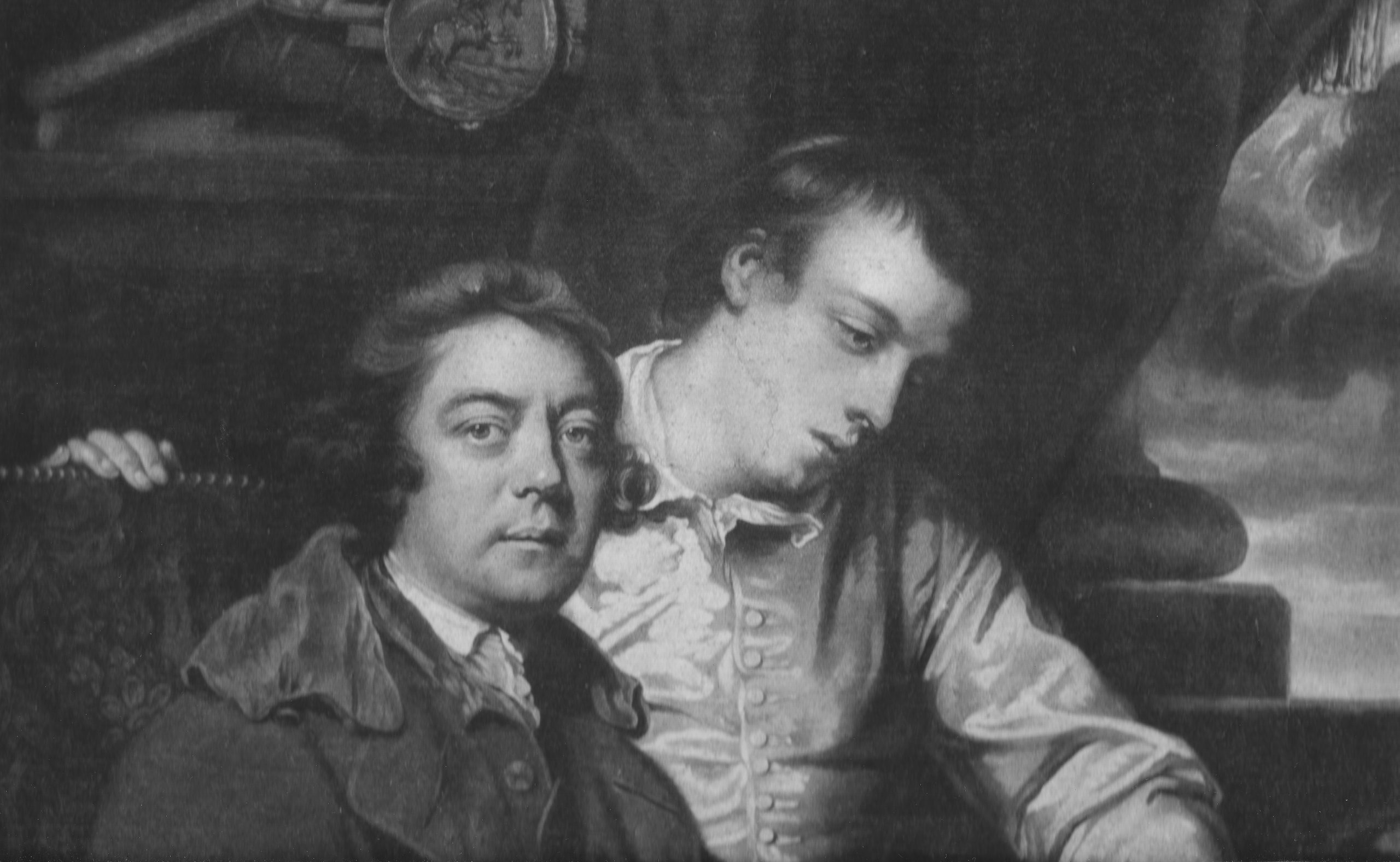
Our completed projects
See the Chimney Piece from Axwell Park, an elegant ornamentation of a Palladian Chimney Piece dating to 1758.
Some of our completed projects
Late 18th Century London Town House
Our restoration of the first floor front room Chimney-piece within a late 18th Century London townhouse. The Chimney-piece perhaps attributable to the workshop of the Devall family in Little Portland Street.
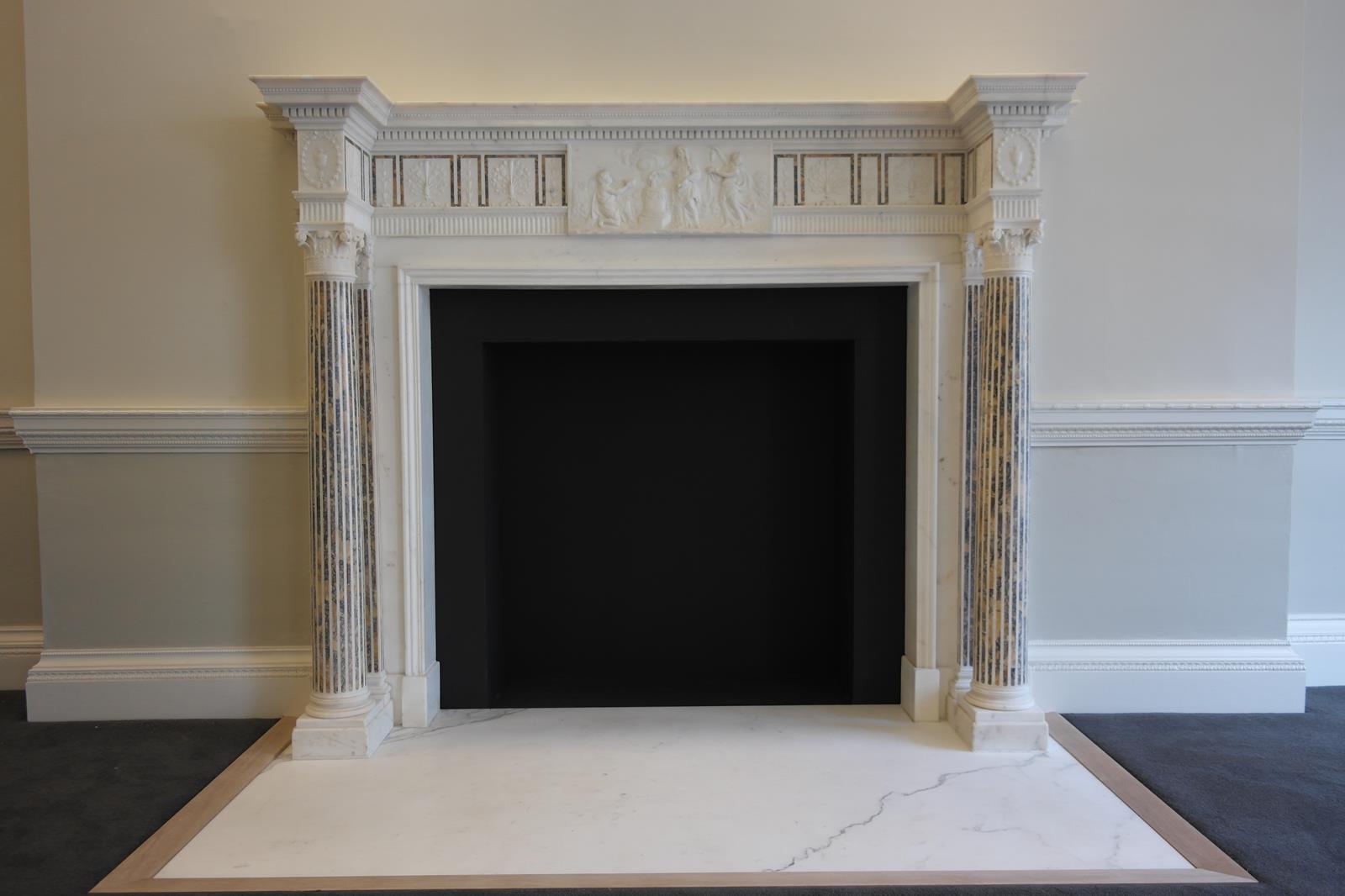
A late 18th century statuary marble chimney-piece carved by John Bacon
The sculptor John Bacon operated a large workshop producing neo-classical Chimney-pieces. This example, made for Lord Irwin’s house, in Portman Square incorporates figures representing the Muses of Drama and Music, after models exhibited by Bacon at the Royal Academy in 1777. The chimney-piece had been poorly stored, the centre tablet had been corroded to the right hand side, and the soffit and Cornice both broken beyond repair. We retained the bed mould and re-constructed the rest of the Cornice and soffit. Despite these replacements Bacon’s sculptural ability is clear, the flowers on the tablet are sharp, and the muses, whose eye line runs through the eye of the flanking capitals, are elegantly worked. The chimney-piece has been re-fitted on a veined marble slab and the fireplace fitted with a Portland hearth and covings.

A mid 18th century Bardiglio and statuary marble chimney-piece from Axwell Park, Co Durham.
James Paine designed Axwell Park for Sir Thomas Clavering from 1758 and this chimney-piece although derived from Palladian prototypes shows Paine’s elegant treatment. The bold form has been lightened by the applications of delicately carved swags of flowers hanging from ribbon ties, a feature typical of many of Paine’s chimney-pieces. Courtesy of James Graham Stuart
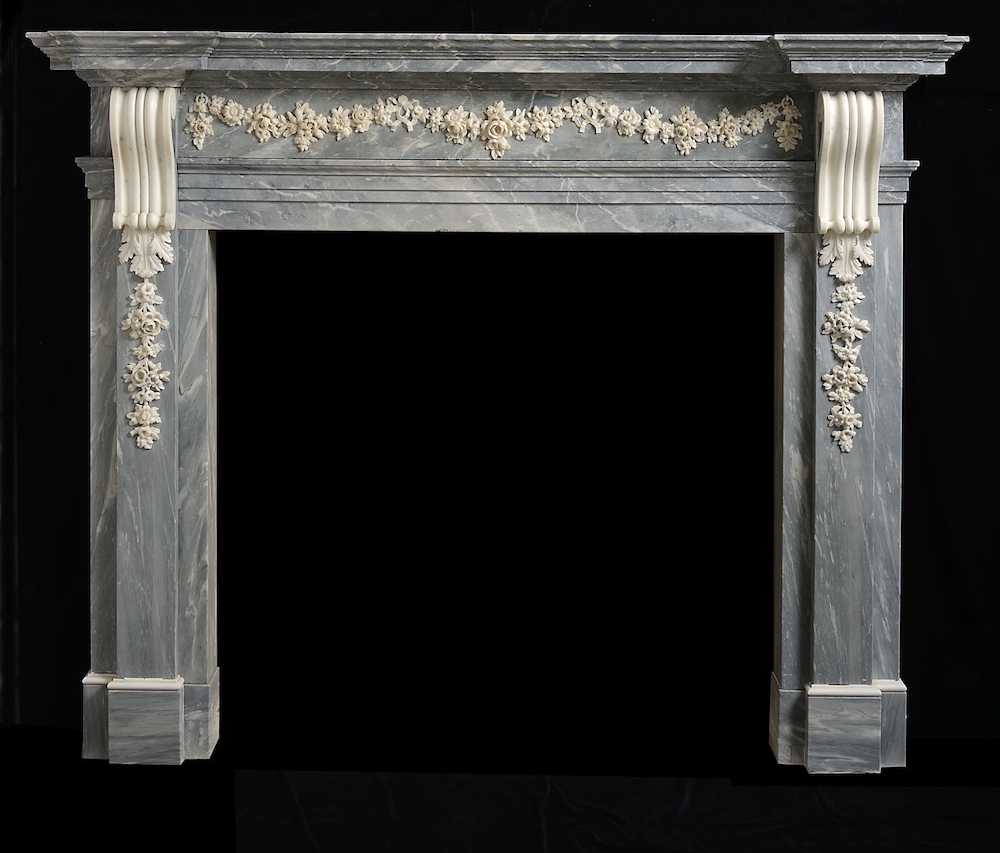
A Greek Revival Chimney-piece from the workshop of Peter Turnerelli
This Greek Revival, Statuary marble Chimney-piece dates from the second decade of the 19th century. The design reflects the influence of the collector Thomas Hope who’s Chimney-pieces were published within ‘Household Furniture and Interior Decoration’ 1807. A related chimney-piece was published in Practical Masonry, 1838, which provides the evidence for Turnerelli’s involvement in its production. Courtesy of Nicholas Gifford-Mead.

Late 18th Century Neo-classical Statuary marble Chimney-piece carved by John Flaxman
The chimney-piece was carved by John Flaxman for Edward Knight’s London house in the early 1780s. The concept and carving are high quality and identifies it as the product of a sculptor, not masons studio. The full front Stove Grate within was made by James Oldham and is of the highest quality combining wrought and cast iron, bright and engraved steel, it incorporates an ingenious system to allow for the grate to expand and contract and be unaffected by the considerable heat of the fire that was generated within it. Our involvement with this project called for the re-carving of a marble pilaster and the reconstruction of the cornice, architrave, and plinth blocks.
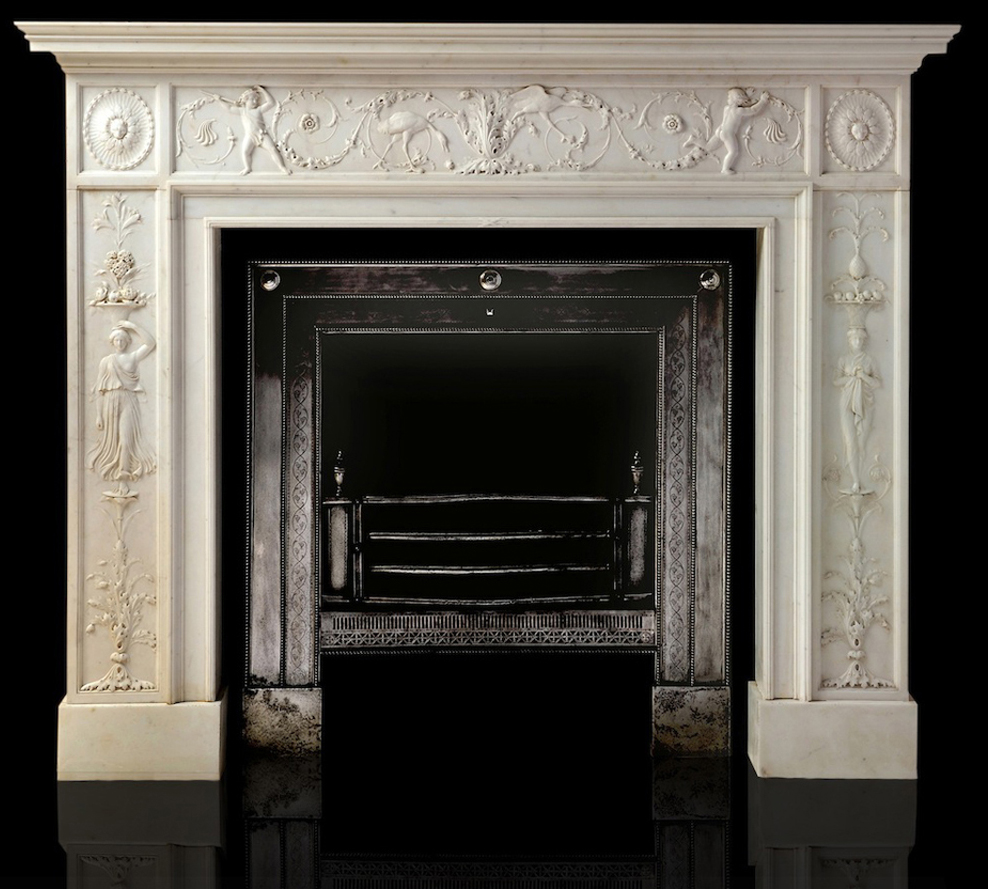
Late 18th Century 1790 Statuary marble Chimney-piece with contemporary cast and wrought iron grate
This Chimney-piece was restored and returned to one of the drawing rooms of a circa 1790 London townhouse and came from the same workshop as the smaller, less enriched model, from an ante room as shown in image 14. With the exception of the carved Paterae within the sunken panels of the blockings the form is the same but larger than its smaller companion. The cast iron, full front, Stove Grate within the opening had become a standard element of most entertaining room chimney-pieces by this date and is contemporary with the Chimney-piece. The bright steel rail, bars, finials, and fret were lightly cleaned and in places, re-polished and the whole re-installed with a Veined Statuary marble slab to match the historic marble as best possible.

Late 18th Century Timber and Composition Chimney Piece by George Richardson.
Designed by George Richardson and perhaps made by the Linnels for Lord Scarsdale’s London townhouse, 41-2 Portman Square, this was an interesting project, for the bulk of the chimney-piece was timber, but the ornament on the frieze was made from composition. This is an early example of its use but was a material promoted by Richardson. The chimney-piece had been overpainted but was originally gilded in part. We had to replace a number of losses, including one of the oval socles at the base of the fluted, oval columns. The internal architrave had been lost but was re-constructed using examples from designs published by Richardson within his A New Collection of Chimney-pieces, ornamented in the style of The Etruscan, Greek, and Roman Architecture, 1781. The chimney-piece has been installed with a Portland stone hearth and veined marble slab.
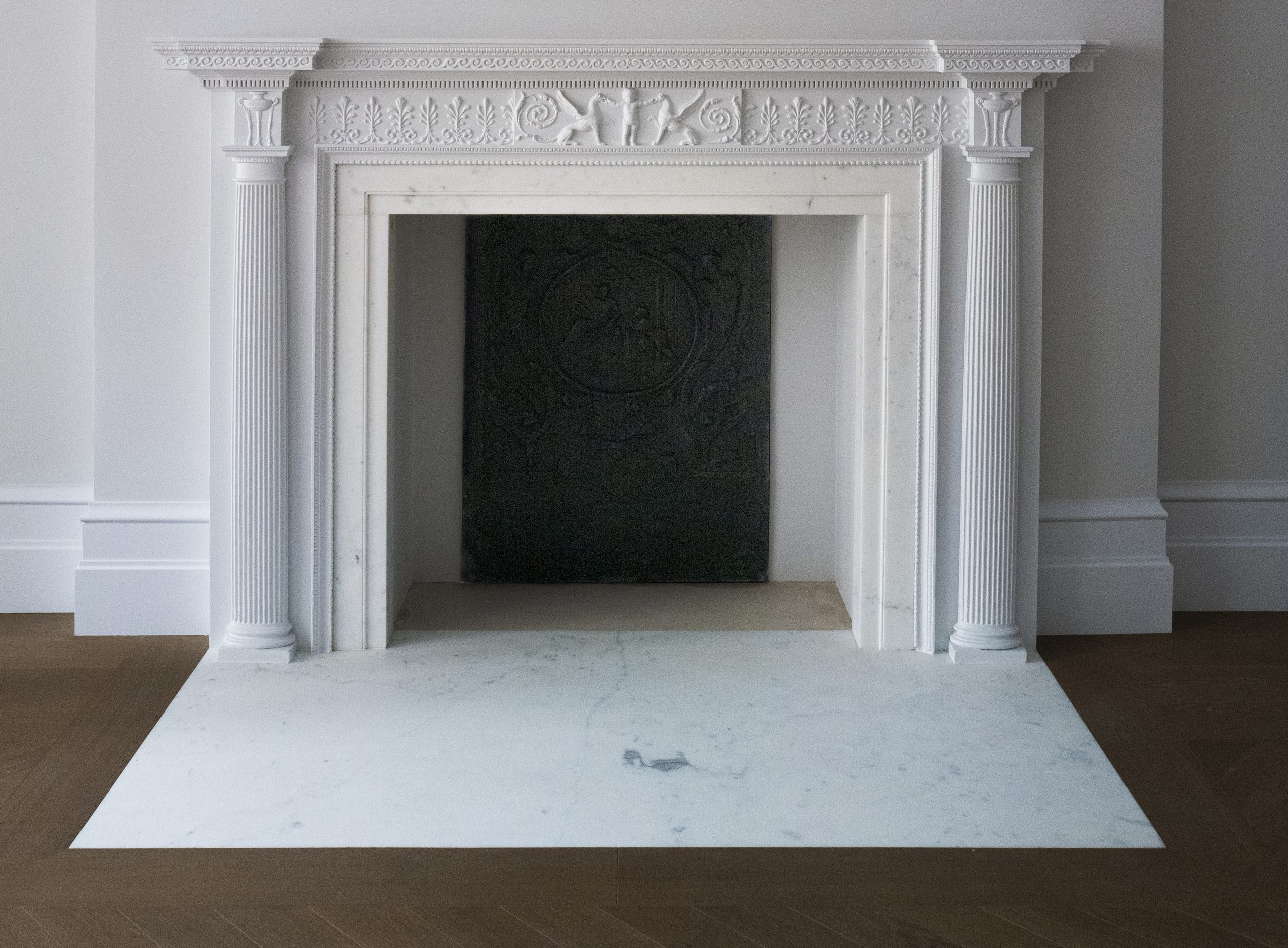
A late 18th Century Statuary and Sienna marble Chimney-piece.
The restoration of this imposing marble Chimney-piece from 11 Bryanston Square required the extensive cleaning of the incredibly coal smoke-stained marble. The original architrave, carved with Egg and Dart, survived in parts but required replacing. The Sienna marble that contrasts so well with the Statuary is particularly well figured, and the craftsmanship of execution is extremely high. Despite appearing as one, both columns are formed from two pieces of Sienna marble, the joint appearing to the center is barely visible. Forming junctions on a column, with an Enthesis, is complicated and illustrates the high quality of craftsmanship of Georgian statuaries and masons during the period. Courtesy of a London Estate.
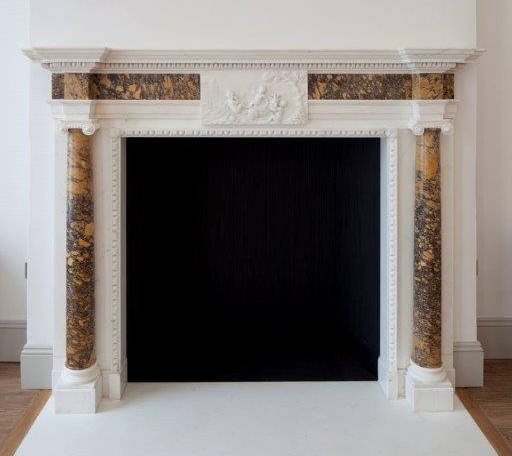
Late 18th Century Statuary and Tiree Chimney-piece
The use of Tiree marble, from the Scottish island of that name, within English Chimney-pieces dates to the late 18th Century and was used within a number of houses including Inveraray, Burghley, Shalford, Knebworth, and Wardour Castle. The pink ground contrasting with the pure Statuary marble most elegantly. This Chimney-piece, formerly in Badger Hall, Shropshire, was installed by us to replace an original which had been stolen. The full front Stove Grate within the opening was installed with white marble slips, to the client’s specification. However, this is not architecturally correct, in that polished black marble would have been used originally. The stove grate is a late 19th Century copy of an 18th-century original.

An early 18th Century Portland Stone Chimney Piece from the workshop of Sir Henry Cheere, showing Vitruvian infleunce
An 18th century, English, carved Portland stone chimney-piece, from the workshops of Sir Henry Cheere, circa 1738. The two rams charging towards each other are found on a number of chimney-pieces produced in Cheere’s workshop and allude to the description, by Vitruvius, of the discovery of the marble used to build the temple of Diana at Ephesus. There is underlying humour here, for the stone used in its construction was the stone used to build one of the wonders of the 18th-century world, London. We removed numerous layers of paint, extensive coal smoke deposits beneath and effected a small number of repairs. Courtesy of James Graham Stewart.

Henry Wood for Carlton House Octagon Room
The late 18th century veined Carrara marble chimney-piece carved by the statuary Henry Wood to the designs of Henry Holland for Carlton House. The elevation and section of Holland’s design for this chimney-piece are held by the RIBA. Unlike many Georgian period chimney-piece, the external returns of the jambs are deeper than the internal returns, reflecting its original placement within a niche with a plinth and statue resting upon the Cornice. The frieze had been broken in the past and those surviving elements poorly stored. We cleaned and removed the surface, extracting areas of iron oxide and coal soot staining from within the marble and supplied a new set of internal returns, slab and Cornice, to match the historic original the original as best possible.
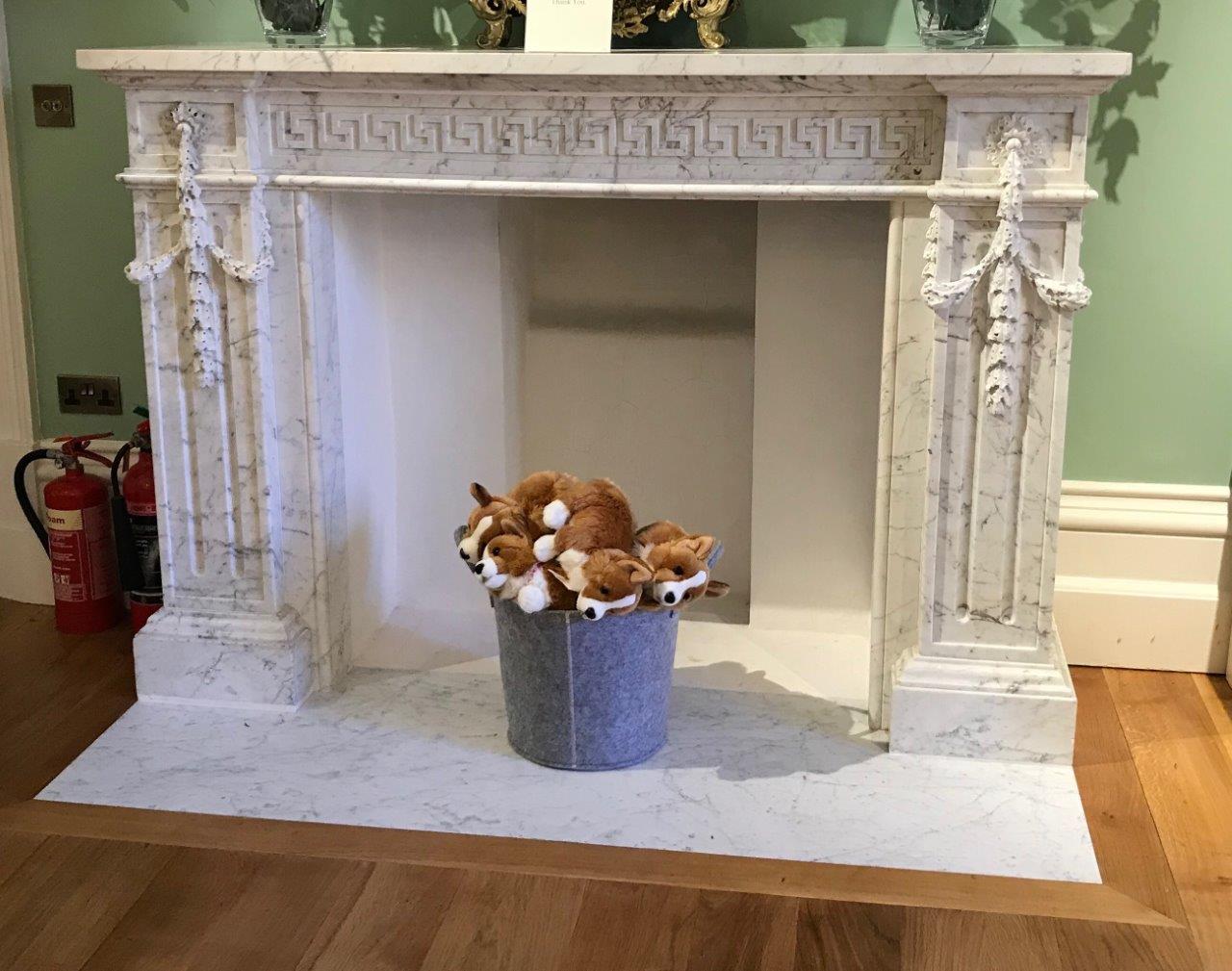
Late Regency period statuary marble chimney-piece
The columns, capitals, plinths, and frieze were the only elements of this early 19th century chimney-piece that had survived a removal in the 1960s. We sourced a block of statuary marble to re-construct the panels, internal returns, cornice, and a new slab. The full front stove grate within the opening is a fine example of the extraordinary improvements that took place in the last decade of the 18th century and the first two decades of the 19th century. Lamentably it had lost the bars and rail that formed the front of the grate which required re-construction
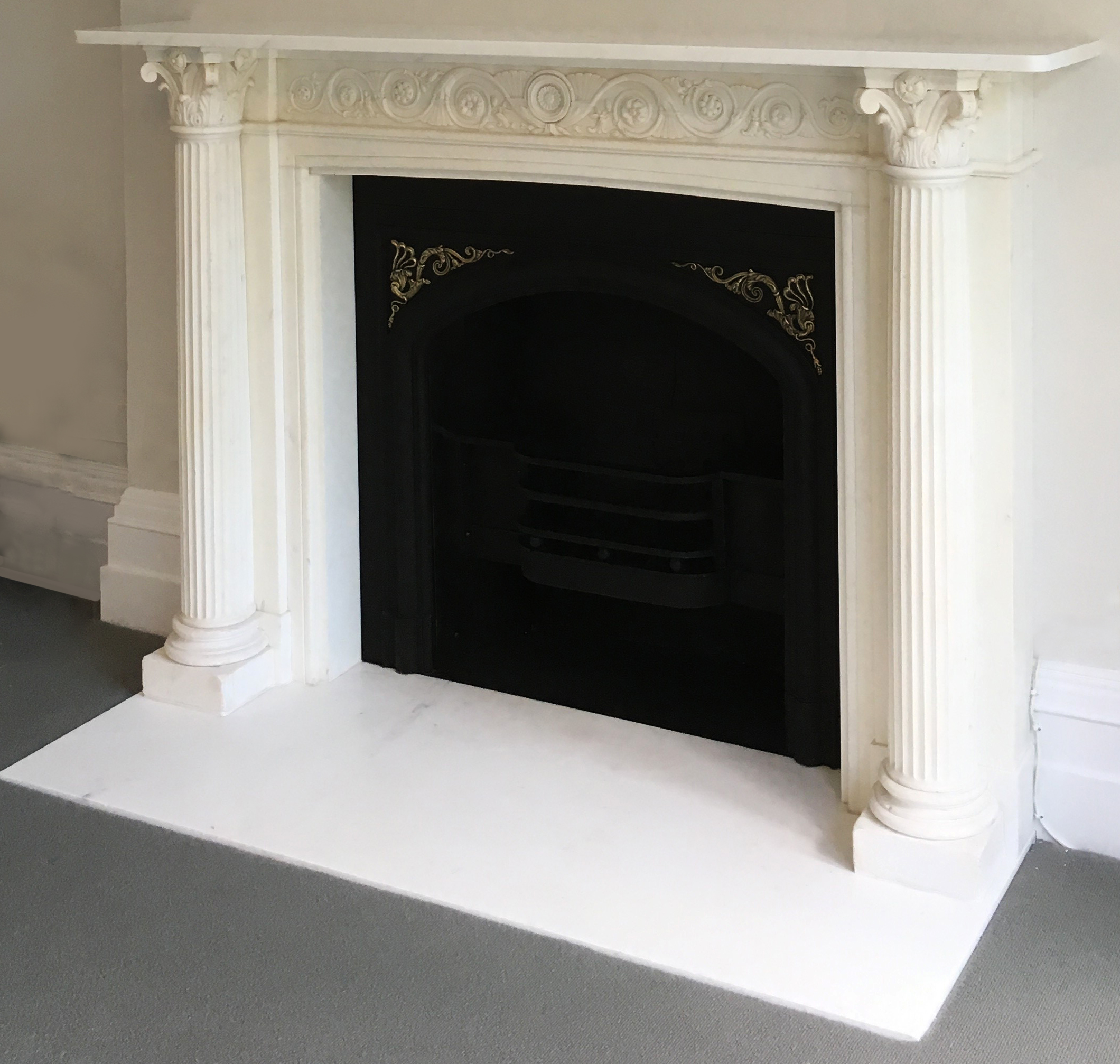
A mid 18th Century Beer Stone Chimney-piece designed by Sir William Chambers and almost certainly from the workshop of Joseph Wilton.
The restoration of this Chimney-piece required the dismantling of both jambs and their correct re-assembly. The Chimney-piece was removed from Parkstead House which Chambers designed in the early 1760s. Chambers used a similarly designed marble Chimney-piece for the dressing room of Gower House, Whitehall, several years later. Joseph Wilton was appointed statuary to King George III but operated an extensive workshop carving chimney-pieces, many to the designs of Sir William Chambers. The sharp crispness of the carving of the frieze is typically of the quality of his workshop. Courtesy of James Graham Stewart
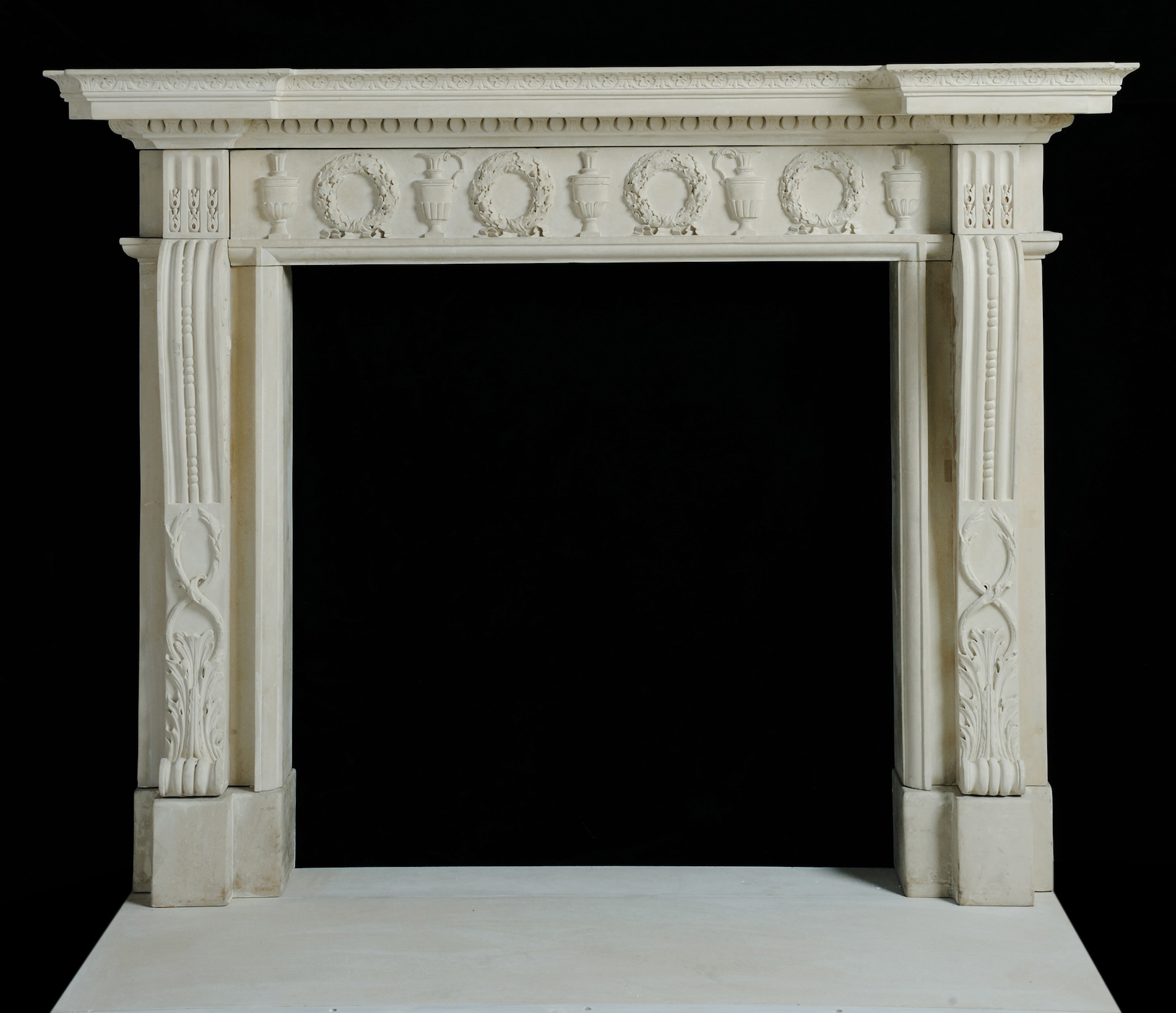
Late 18th Century circa 1790 Statuary marble Chimney-piece
This simple and elegant Chimney-piece has sunken panels and was fitted in an anti-room of a circa 1790 London townhouse. The original chimney-pieces within the larger rooms have carved Paterae ornament to the blockings, reflecting their greater size and importance of those rooms. The cast iron, full front Stove Grate, retained it’s adjustable register and is contemporary with the Chimney-piece. The bright steel rail, bars, finials, and fret were lightly cleaned with minimal re-polishing, and the whole re-installed with a Veined Statuary marble slab to match the original as best possible. Note the extent of the slab which corresponds with the width of the chimney-piece at board level.
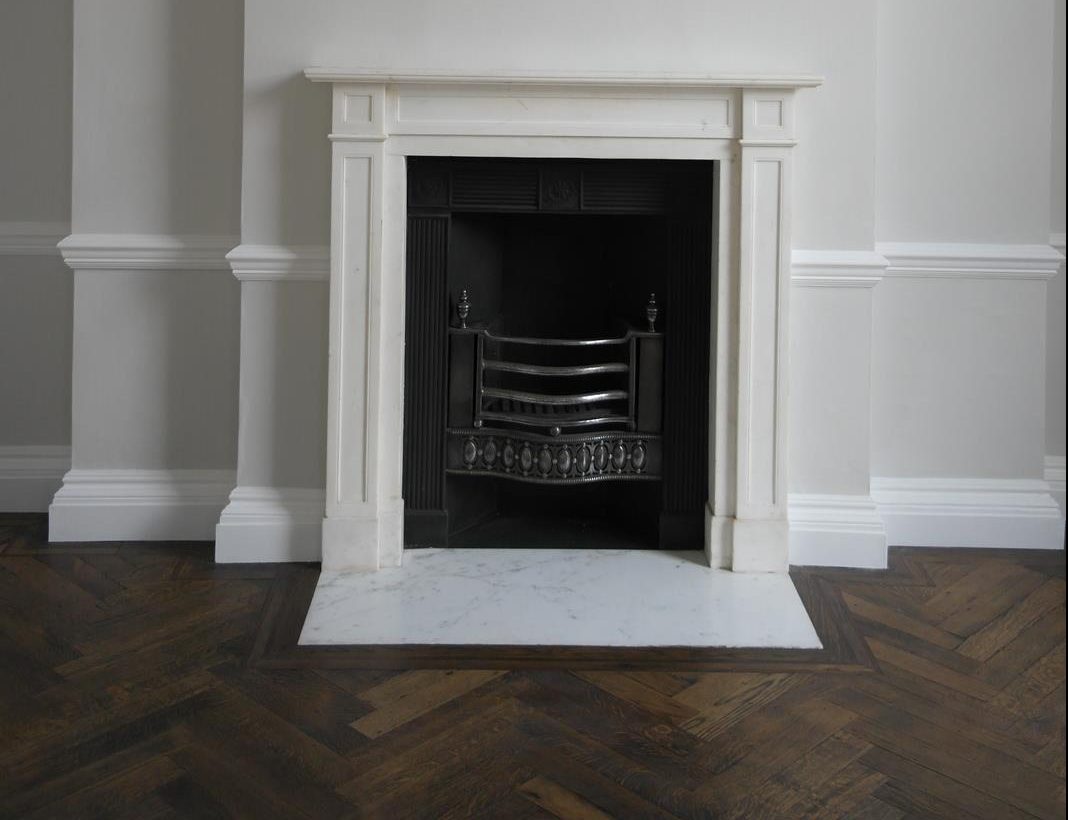
The extraordinary 18th Century Statuary and Sienna marble Chimney-piece by John Francis Moore from Fonthill Splendens.
This Chimney-piece has been located within a great number of British mansions. In 1998 we were asked to remove, clean and reinstall it in the ground floor room of a London townhouse. It is one of John Francis Moore’s finest Chimney-pieces and demonstrates the technical skills of the sculptor, as well as the magnificence of English Chimney-piece productions in the mid-18th Century. The sculptured figures are elegantly cut and the carving has a tremendous depth, the statuary marble contrasting beautifully with the veneered Italian Sienna marble that forms the ground.
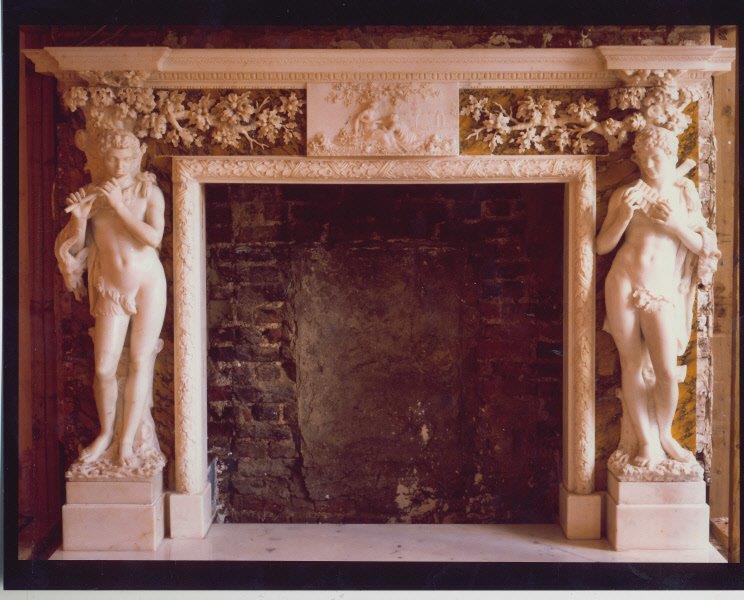
‘The Grecian Feast’ by John Flaxman
The extraordinary Red Granite and Statuary marble Chimney-piece carved by John Flaxman for The Grange, in Hampshire in 1823-4. Flaxman based two of the bas-figures from the Grecian feast on antique roman originals and composed the rest of the figures himself. The stove grate with reflector plates is contemporary with Chimney-piece. Courtesy of the late Christopher Gibbs.

A late 18th Century Statuary and Sicilian Jasper Chimney-piece by John Francis Moore, from Stackpole Court, Pembrokshire.
This chimney-piece originated from the workshop of John F Moore for he used an identical relief of a greyhound in a circa 1770 drawing for a Chimney-piece for Marlborough House. The Chimney-piece was in poor condition and required a complete reconstruction. The ornamental Sicilian Jasper used in contrast to the Statuary marble was commonly used by many Georgian craftsmen including one of Moore’s competitors, Sir Henry Cheere, to whom this Chimney-piece was formally attributed. Courtesy of James Graham Stewart.
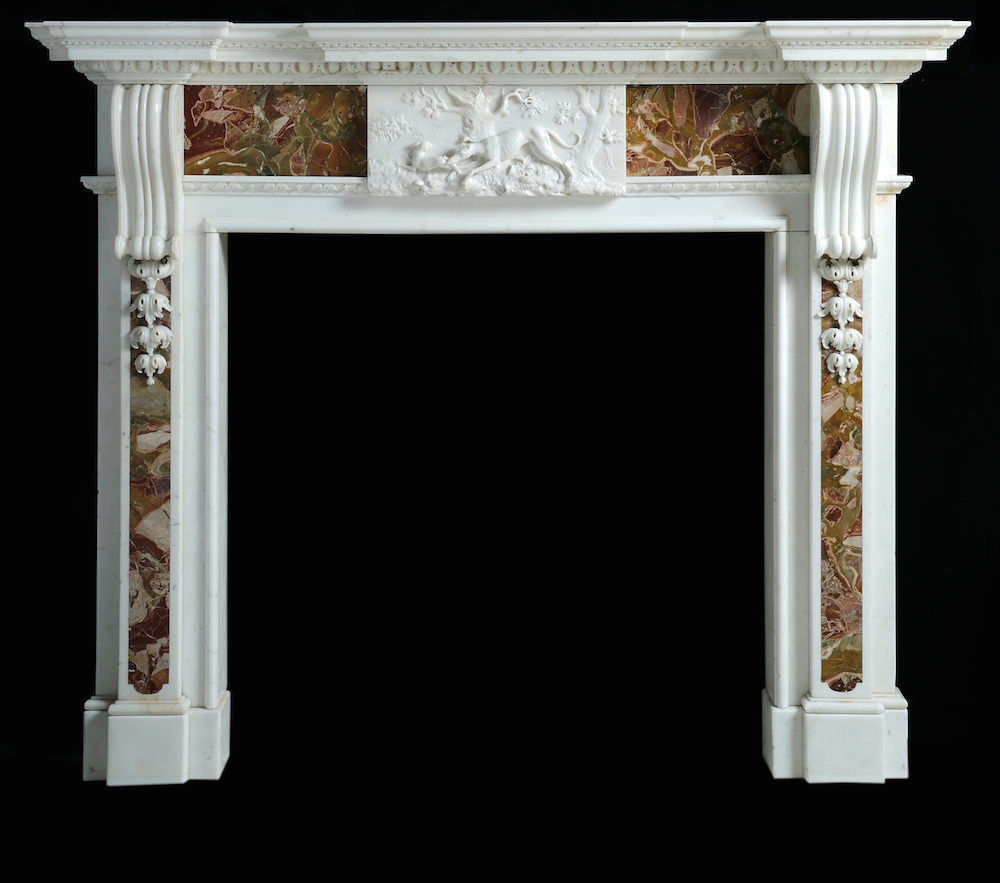
Designed by Isaac Ware, once in the Dining Room of Hamilton Palace
This highly decorated, mid18th Century. English, Statuary marble Chimney-piece was designed by Isaac Ware who published a related design within his 1756 ‘A Complete Body of Architecture’. The ‘heads we have placed above the scabbards in the middle parts, are a great article of this elegance’ The chimney-piece was, at some point, in the Dining Room of Hamilton Palace and may have been carved in the workshops of Ware’s, father in law, James Richards, Master Carver to the Office of Works. The design, like many of Ware’s chimney-pieces, ultimately derives from Palladian sources, in this instance, Inigo Jones. Courtesy of Nicholas Gifford Mead.
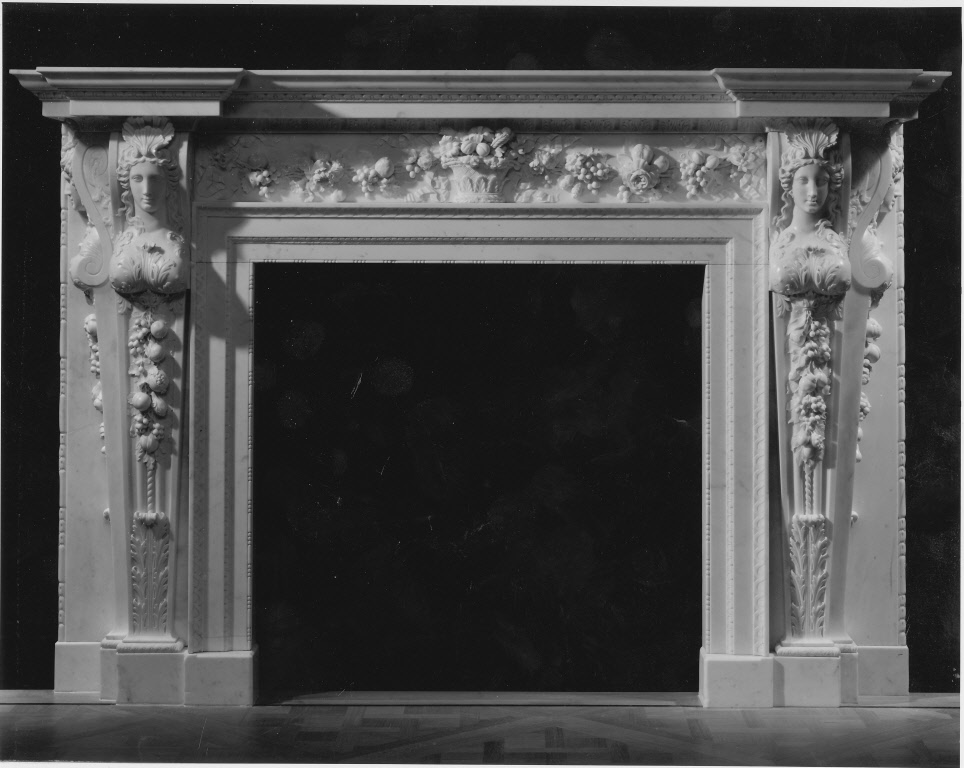
A mid 18th Century Statuary, rococo marble Chimney-piece designed by and cut in the workshops of Sir Robert Taylor.
Sir Robert Taylor’s extraordinary elegant designs in the Rococo manner are instantly recognisable. The Palladian ideals have been manipulated in favour of the C Scroll and Rocaille ornament, and the classical pediment flattened, but the square opening of the aperture remains. Taylor used this form for a great number of chimney-pieces and occasionally for monuments. Courtesy of Nicholas Gifford-Mead.

A Statuary marble Chimney-piece carved by James Lovell for the State Drawing Room at Stowe, 1758-9
The design of this Chimney-piece, like that from Hamilton Palace, derives from a design by Inigo Jones for Greenwich (J. Vardy Some Designs, plate 7). However, the treatment of the frieze corresponds to designs by James ‘Athenian’ Stuart, who must have been involved with design. Lovell reused the main Terms of Minerva and Mercury for another Chimney-piece in the Gallery at Hagley Hall. Such practices were common in the 18th Century, enabling sculptors to reuse terracotta models for different projects. The Chimney-piece required extensive cleaning and re-assembly. Courtesy of Carlton Hobbs.
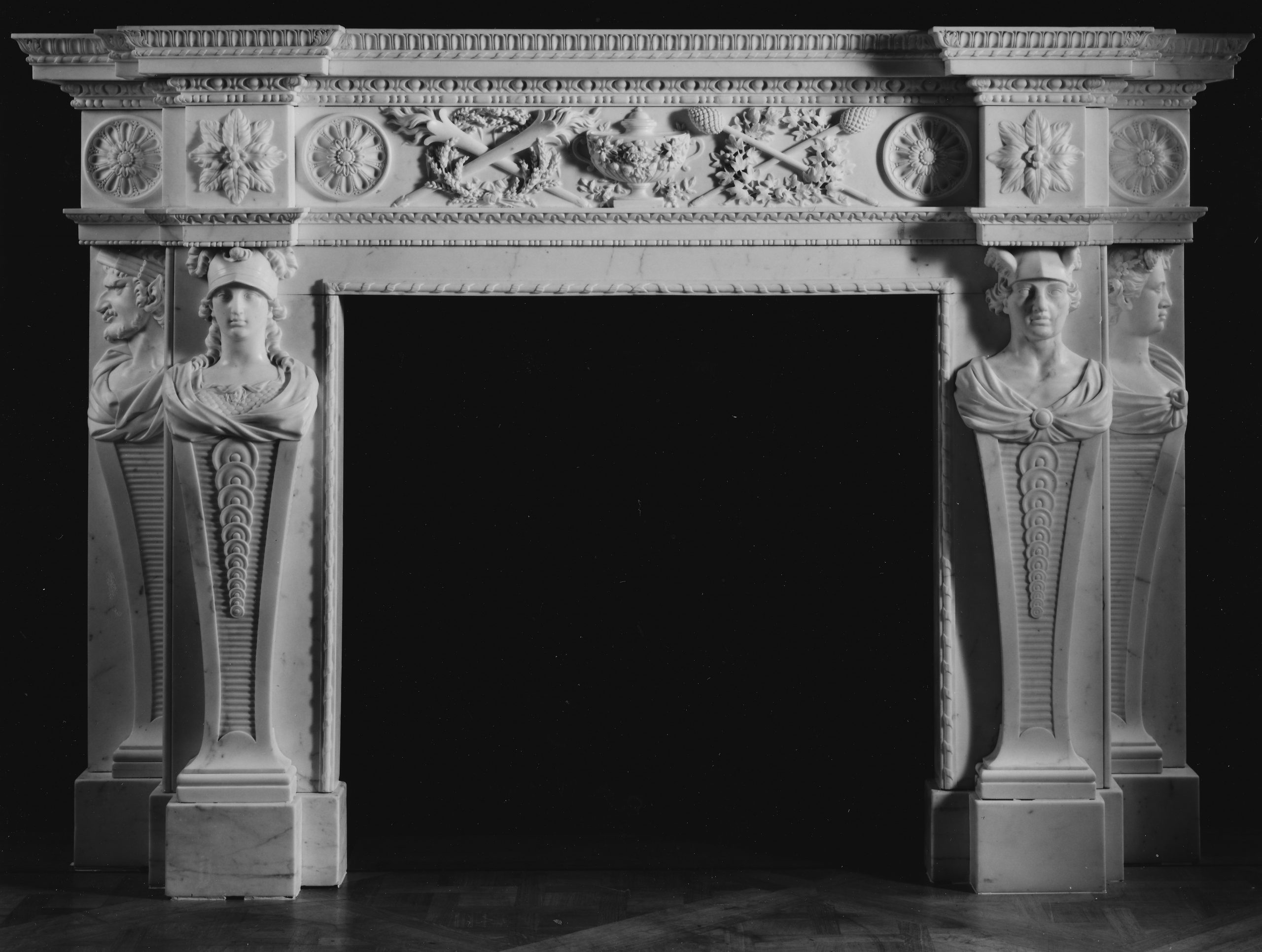
We've worked on pieces designed by
- James Paine
- Robert and James Adam
- Henry Holland
- James Wyatt
- Sir Robert Taylor
- Inigo Jones
- Richard Boyle Third Earl of Burlington
- Sir William Chambers
- James Gibbs
- Isaac Ware
- Sir John Soane
- Sir Robert Smirke
- Batty Langley
- James Byres
- George Richardson
- Carr of York
- George Dance
- Matthew Brettinghan
- Henry Flitcroft
And carved by
- Sir Henry Cheere
- Robert Taylor
- John Michael Rysbrack
- John Francis Moore
- Joseph Wilton
- Peter Turnerelli
- Richter and Bartoli
- Richard Hayward
- The Devalls
- John Flaxman
- James Lovell
- John Bacon
- Thomas, Benjamin and Thomas (younger) Carters
- Mathew Brettingham
- John Wildsmith
- James Paine
- And many others